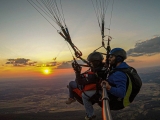But... when there's no snow... do we stop skiing? Not necessarily, because we can still do it! How? By grass skiing.
Although very few people in Spain have tried it, it's a sport with some relevance in northern and central Europe, particularly in Germany and Austria, though there are also competitions in Italy, Slovakia, and Turkey.

Looking back in time, the first known record of grass skiing dates back to Austria in 1893, where a kind of "rolling ski" was designed, which likely wasn't very successful. But in Germany, things changed, mainly due to the support of Emperor Josef. In 1956, a prototype was presented in Stuttgart that allowed skiers to descend the same slopes and trails used in winter on snow. This first model wasn't taken very seriously, but its creator didn't give up, and by 1963, around 30 models had been developed due to the many modifications introduced. Grass skiing had been born.
But it wasn't going to be easy. In Germany and the rest of Central Europe, people were still very sceptical about this new sport, even leading to disputes with the German federation, which disagreed with the use of the term "skiing." This didn't matter to the enthusiasts who enjoyed grass skiing regardless of what others chose to call it.
Thanks to TV coverage, it gained popularity in the United States and Japan, where a strong following emerged, leading to the first international competition being held in Owen Teck in 1965.

In 1970, a committee was formed to organise the European Cup events. In 1976, the International Grass Ski Federation was founded, and the first World Championships were held, followed by editions in 1981, 1983, and 1985. But 1985 also marked a major institutional change. After lengthy discussions, the FIS (International Ski Federation) decided to take over grass skiing, organising World Championships in Nobeyama 1987 (Japan), Austria in 1989, Bursa 1991 (Turkey), Aciago 1993 (Italy), Kalnica 1995 (Slovakia), and Muestair 1997 (Switzerland).
To better understand all this, let's look at some of the technical characteristics of both the course and the equipment used in competition.
- Course Characteristics
The starting gate will be fitted with carpeting along its entire length, with a flat zone where the skier positions themselves and a ramp with a maximum incline of 12%. Additionally, the area where the poles are planted for the initial push will be reinforced.
Slalom
The course will have a gradient of between 60 and 120 m to accommodate both men and women. The length of the course will range from 250 to 500 m, with at least 30 gates (maximum 45).

Giant Slalom
The gradient will be between 80 and 150 m. The course length will range from 400 to 750 m. The number of gates depends on the gradient, calculated using an appropriate formula, allowing for 5 gates more or less. The distance between two consecutive gates must be at least 10 m. This event is run over two rounds.
Super-G
Gradient between 100 and 180 m with a course length of 500 to 900 m. At least 12 gates will be set (usually more), with a minimum distance of 12 m between them.
Parallel
In parallel events, the gradient should be between 40 and 60 m, with each skier passing through 10 to 20 gates. Additionally, many of these courses include a jump halfway through.
- Equipment
All models have a maximum length of 80 cm and a height of 12 cm. Although unauthorised equipment cannot be used in competition, a designated area will be allocated post-race for equipment testing, with disqualification for those who test outside the marked zone.

Helmets are mandatory in all junior and youth events. In the general category (men and women), they are only compulsory in Super-G, while optional in Slalom and Giant Slalom.
For ski maintenance, due to the need for proper lubrication, any biodegradable and non-polluting substance may be used. However, cleaning and greasing the skis may only be done in specially prepared areas.
We must not forget that, like every FIS-regulated sport, general procedures must be followed by competitors regarding advertising and respect for officials appointed by the organising federation, as well as by officials themselves, who must be properly trained in regulations and safety.











